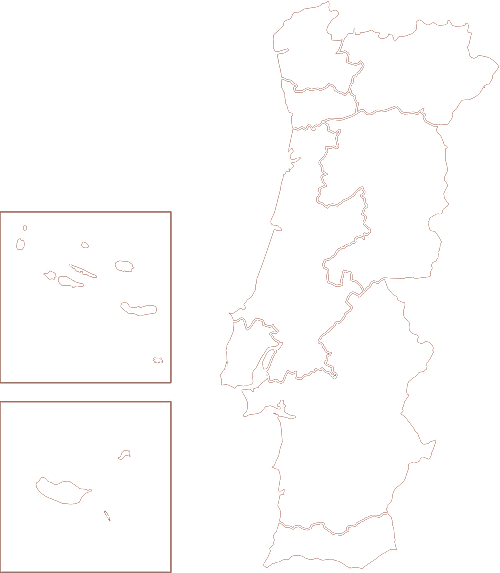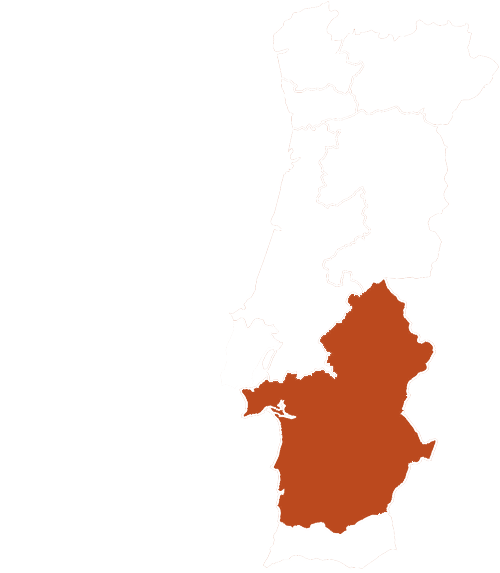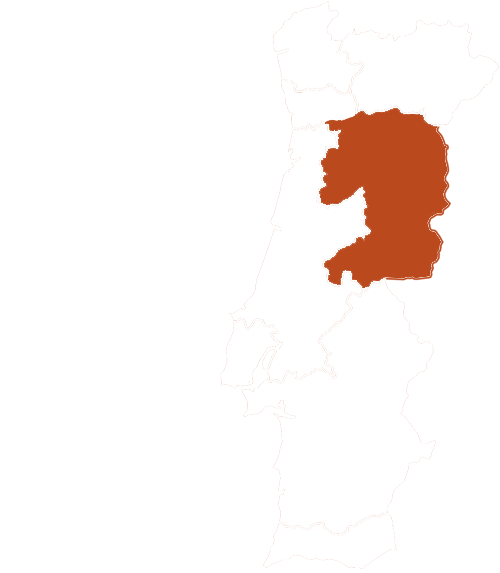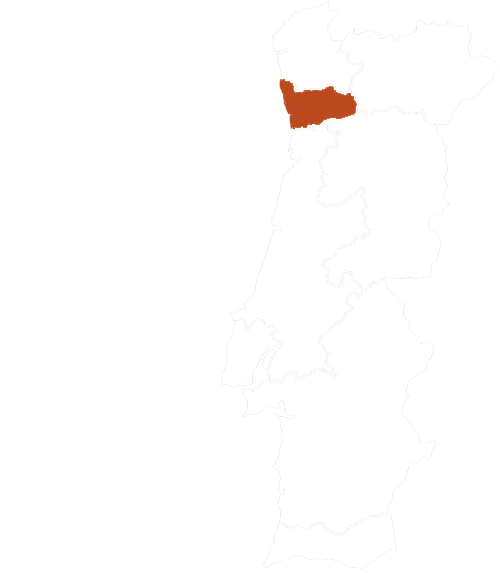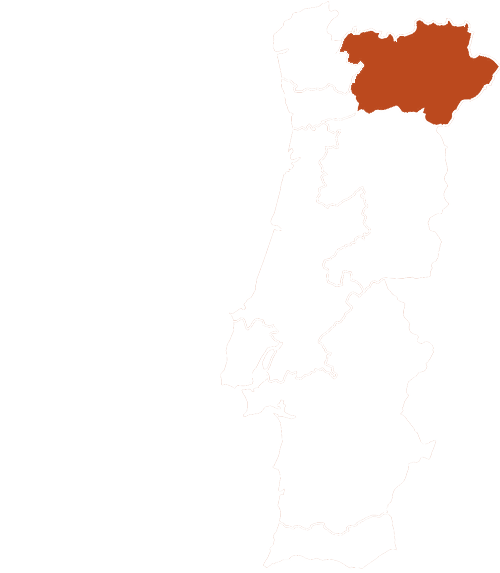We are deeply committed to add meaningful experiences to your biography and help you to make a journey that will bring you back in time, close to your roots. With a Geneological Journey, like the one we are suggesting,you can read a little bit of the story of one of our travelers, who discovered that his roots spread across Portugal, along amazing places. We can tailor your own journey!
Let’s start…from the beginning! The great-grandparents of our traveler (from his father´s side) were born and raised in a small village called CASTELO DE VIDE. Their entire life was lived around this region.
Arrive in Lisbon and pick-up your rental car.
Drive from Lisboa to Castelo de Vide (220 km), which takes around 2h30 minutes.
In the heart of São Mamede Natural Park (“Serra de São Mamede”), you will find Castelo de Vide, the village of the great grandparents of our traveler and the beautiful and historic surrounding villages that will show you a genuinely deep Portugal.
Castelo de Vide is a beautiful village in Alentejo, on a hill in Serra de São Mamede. Crowned by the castle, this town is full of history and several megalithic legacies in the area such as the Menhir of Meada. Castelo de Vide boasts one of the most important and well-preserved examples of the Jewish presence in Portugal dating from the 13th century. One of the largest estates of civil architecture from the Gothic period is also preserved here. In the majestic Square D. Pedro V (King Peter the V), you can find the Church of São João Baptista (St. John the Baptist), the Hospital, the Main Cathedral, the Town Hall and several stately and emblazoned mansions.
Continue to Marvão
Very near to the Spanish border, at the highest point of the beautiful Serra de São Mamede, lies the charming village of Marvão in an environment of peace of mind and tranquillity, surrounded by walls of the 13th and the 17th century.
Once in Marvão, you can visit its narrow streets of Alentejo architecture, Gothic heritage, Manueline and testimonies of other medieval times, marked in the typical local granite. The Castle is an unforgettable monument of the village, but Marvão has more to offer, like the 15th century Cathedral, the ancient Church of Santa Maria (St. Mary´s Church), now an interesting municipal museum, housing archaeological and ethnological collections from the region. From the top of Marvão you have breathtaking views across the surrounding area, highlighting the Pousada de Santa Maria (St. Mary´s Inn).
The extraordinary detail about this day is the possibility to enjoy and learn about culture and history while you can enjoy the landscape of the Natural Park. Wild boars, foxes, rabbits, badgers and wild cats, rare birds such as Bonelli's eagle (the symbol of this protected area), griffons, hawks, copper eagles, and the owls of the bush…they are all part of the biodiversity of the São Mamede Natural Park.
You can enjoy a quick road trip to discover these preserved and less known places or choose to take a walk or ride a mountain bike route, choosing one of the marked paths.
You can have lunch at one of the typical restaurants that serve delicious food from Alentejo.
The hotel chosen for you, is full of character and embraces de local culture, being inspired by the former inhabitants of the nearby Roman ruins, it is another way we found to help you discover more about your ancestors.
Accommodation in one of our suggested Luxury, Premium or Boutique Hotels.
“Alto Alentejo”, land of pure horses, brought our grand- grandfather to work with this majestic animal. Since very young he was a stable hand, taking care of the horses. In ALTER DO CHÃO, Portalegre district, the great-grandson could see, feel and understand more about this art.
Drive from the hotel to Alter do Chão (25 km) that takes around 30 minutes.
Here you will visit the Coudelaria Alter Real, founded by king D. João V in 1748, with the purpose of breeding Lusitano horses for the Royal Paddock. This was one of the most important Lusitano breeding institutions in the country and it kept the kings expressed wishes of preserving the Lusitano purebred. Nowadays the Coudelaria holds several activities in its 300 hectares of beautiful landscape.
Here you will find the Agricultural School, the Portuguese School of Equestrian Art, a Campus of the Évora University, with research centers for selection and improvement of the Lusitano purebred, equestrian and sports infrastructures, as well as a Falconry where you can view several falcons and enjoy a presentation.
The Coudelaria also offers different educational activities, focused on the development and dissemination of environmental preservation and Lusitano heritage. If you are able to view the mares leaving for pasture (which in Portuguese we call “Éguada”), it’s an amazing experience.
Suggestion for lunch in Alter do Chão with traditional Alentejo dishes.
In the afternoon we suggest making the most of your hotel. Here you can participate in different experience in a relaxing environment, that can suit the all family: from the adult wine tastings, to the SPA, to the child friendly cooking workshops that will teach you more about the Alentejo cuisine. If you don´t feel like having a formal meal, it is also possible to enjoy a pic-nic at sunset! Just let us know how you would like to make your day complete!
Accommodation in one of our suggested Luxury, Premium or Boutique Hotels.
FUNDÃO is another important city for this family. Located in the province of Beira Baixa (the region that we call, in Portuguese, “Beiras”), the parents of our traveler´s grandmother were “Beirãos”. Fundão was the small town where the grandmother of our traveller worked. Like most of the locals, by the summer months she would be in the fields picking cherries from the trees.
Drive from the hotel to Fundão (150 km). The drive takes around 1h40 minutes.
Today is a day to roll-up the sleeves and have lots of fun!!
We planned a visit to a local farm where you can participate in the cherry harvest*. This unique experience will teach you the special and traditional techniques, used by the grandmother, and enjoy the incomparable taste of the fruit, hand picked from the tree.
Cherry is the “queen fruit” of Fundão (cherry, ou cereja, is a feminine name in Portuguese). Between March and April, Serra da Gardunha is dressed in the magnificent white mantle that covers the famous cherry orchards of Fundão.
Stroll a little around the town and pick one of the traditional restaurants that will certainly blend the cuisines from “Beiras” and “Alto-Alentejo”.
In the afternoon you can visit the “Centro Interpretativo da Cereja” (Cherry Interpretive Center). The morning’s experience will be complete with this visit, as well as the understanding of the importance of this fruit for the economy and traditions of this local community!
In the evening, relax at the hotel we chose for you, built in a former monastery. Here you will find a SPA and a natural Salt Cage for Halotherapy, give it a try! This therapy is a totally natural method based on nebulization of crystalline salt microparticles, which reproduces the conditions of the sea environment, normally present on the beaches. The hotel restaurant offers you degustation menus or menu à la carte.
Accommodation in one of our suggested Luxury, Premium or Boutique Hotels.
*Important Note: This activity is seasonal and can be changed according to the dates of your trip.
The grand-grandfather was a traveler himself! As a farmer he used to sell his vegetables and fruits at the small markets and fairs around the region.
Having Fundão as a starting point, this is a special day to discover the small villages of the region. With the guidance of a local special guest, this private tour will take you to the twelve “Aldeias Históricas” (Historical Villages). In each village you will taste the typical food and have a complete understanding of the “Beiras” gastronomy.
Made of granite and shale, the historic villages preserve stories of ancient conquests and traditions and dazzle the landscape, heritage and friendliness of the people who inhabit them.
Set high in the hills, they are distinguished in the distance in the haughty towers of their medieval castles. That is why they are strategically aligned along the border, so that Kings and Lords of the land could sleep more peacefully. However, they were deceived at times; Moors and Christians, Castilians and Portuguese, all tried to take these villages for themselves and so each has a very old story or a legend to tell. Today these are very peaceful villages and boast in the stones of the streets and houses what Portugal has of most genuine: the authenticity of its people and the pride of a History of over 900 years.
As you probably already know and experienced, Portugal is all about the food! “Petiscar” (the art of snacking) along these 12 villages will probably accommodate your stomach for the day!
Accommodation in one of our suggested Luxury, Premium or Boutique Hotels.
Like most of the inland, the countryside of Portugal was always agricultural. Every year, the grandparents of our traveler used to visit a brother (his great uncle) in VILA NOVA DE FOZ CÔA and help him with the olive picking or the almond picking. It was hard work but well rewarded with a proper meal.
Drive from the hotel to Vila Nova de Foz Côa (135 km) that takes around 1h30 minutes.
The region of the Côa Valley is internationally recognized for its importance in pre-historical rock art, which in 1998 was assessed by UNESCO as World Heritage. This distinctive classification led to the creation of the Archeological Park of the Côa Valley and the Côa Museum.
A preliminary visit to the Museum helps understand the carvings that we shall see. Millennium after millennium, the shale rocks that surround the bed of the River Côa slowly became panels of art, with thousands of engravings bequeathed by our ancestors' creative impulse. Dating back to the Later Paleolithic, these outdoor panels and identified habitats are proof of the settlement, vitality and a mastery of design, transposing two thousand years of History from the Neolithic and Iron Age. The three available sites to visit are located in the valley of the river Côa, accessible only by jeep. The visits start from different places: from the Côa Museum to Canada do Inferno, from the Reception Center in the village of Castelo Melhor to Penascosa, from the Reception Centre in the village of Muxagata to Ribeira de Pisco. The route must be chosen and booked well in advance!
Everything is easily forgotten when we sit at the table and we start to snack on rye bread and olives, to accompany fried river fish or eels as a house specialty. If you prefer, choose the game meat and accompany the meal with a local wine.
Accommodation in one of our suggested Luxury, Premium or Boutique Hotels.
For a long time, donkeys were the main transport for the common people of this regions and for the family that we are following. They were used by the locals to work the land, to transport themselves and to take food to the market.
Drive from the hotel to Atenor (105 km), right at the border of Douro International Natural Park. The drive takes around 1h20 minutes.
The Miranda donkey has unique features: dark-brown hair, a bit lighter on the back and underside of the trunk; long and thick fur; big ears; large head; high stature, higher than 1,20m; and tame temperament. It is an endangered species and the local associations are working to protect it by promoting some activities, such as rides.
Visit one of these Organizations, to get to know a Mirandeses donkey reserve and for a donkey ride.
If you are a meat lover, try a “Posta à Mirandesa” from a local restaurant in the Douro International Park, just a 30 min drive away, it´s totally worth it! “Posta” means a chunk of meat, and this meat comes from the veal of the Mirandesa breed, cooked on the grill, it is tender, juicy and delicious!
Drive to Bragança
Bragança was born in the 12th century and the medieval center remains quite untouched; it is characterized by the imposing Castle, the Pelourinho (Pillory) resting on an unusual Lusitanian “berrão” (pre-historic granite pig), the Church of Santa Maria (Saint Mary) and the Domus Municipalis, a unique piece of architecture.
After king Manuel granted the New Charter in 1514, the city's development was largely due to the bishops who would reside here for half of the year. The royal and Episcopal influences characterizing those times are reflected in the Church of São Vicente (St. Vincent), the Museum of Abade Baçal, the Chapel of Misericórdia, the Church of Santa Clara (Saint Claire) and finally in the Cathedral. Complete the visit with the nearby Church of Castro de Avelãs. Bragança is a beautiful historical city, with a strong medieval legacy.
Accommodation in one of our suggested Luxury, Premium or Boutique Hotels.
Portuguese families can be big!!In BRAGANÇA we found an aunt of our traveler, that moved to the town to marry with a “Bragantino” (local from Bragança)!
No tour in this city is complete without a walk through Montesinho Natural Park, where there are still commune style villages that form part of the region’s heritage. The village of Rio de Onor is crossed by the border with Spain. On one side, Rio de Onor, on the other, Rihonor de Castilla. This community village is one of the best preserved of the Natural Park of Montesinho, with typical houses made from shale (“serranas”) with beautiful balconies, very well renovated. If you prefer, the visit can be done with a local guide that will tell you all about the stories of the smuggling, characteristic of this border ! The village is crossed by Onor River, also known as Contensa river, and its river beach, which on warm days, invites moments of rest next to the clear waters.
The normal path to discover the natural beauty of this region is done through the route of Baixa Lombada and Onor, which crosses the villages of Baçal, Sacoias, Aveleda and Varge. Just outside the Park, Gimonde and its Roman Bridge also deserves a visit. “Time Travel” is a common description of the people doing this!
Trás-os-Montes, the province where Bragança is located, has a powerful and austere landscape, which our Portuguese writer, Miguel Torga, named “Reino Maravilhoso” (Wonderful Reign).
The restaurants in this area might not be the most sophisticated but they are certainly genuine and full of friendly people. The decoration is normally rustic with a strong reference to the materials and art of the region.
Enjoy the wonderful gastronomy, where cheese, “salpicão”, smoked ham…are inevitable and incredibly tasty.
Accommodation in one of our suggested Luxury, Premium or Boutique Hotels.
For a Portuguese with roots in “Trás-os Montes”, or in “Beiras”, it is not surprising to have a family member working in the vineyards, producing and enjoying wine! Douro is where we found an uncle of our traveler, doing precisely that!
After an early breakfast, drive from your hotel to Régua (135 km). The drive takes around 1h30 minutes.
Today you will have a private tour to a Douro estate, accompanied by wine tasting. You will be picked up at the hotel, where you can leave your car, and simply enjoy the day and the amazing views! This morning you will visit a “Quinta” (wine estate) and enjoy some wine tasting in the home region of some of the most famous wines in the world, at one of the finest local properties, which reflects the landscape´s character and the true spirit of the valley. Enjoy the aromas and knowledge that man kept through generations.
The Douro region has a stunning landscape, largely thanks to the incessant and hard work of people. The result is an extensive area of vineyards, carefully crafted, which wind along the Douro River. Cruising along the river and enjoying this natural beauty is a unique experience. We reserved a small private cruise for you to enjoy, in the afternoon.
For your lunch, TravelTailors suggests a restaurant in what is one of the most beautiful scenic routes in the country. The restaurant is built on stilts, which extends over an elegant wooden deck overlooking the river. It is a place of enormous beauty, blending the grandeur of the vine covered Schist Mountains with the quiet serenity of the Douro River and the riverside villages, only awakened by the regular passage of the train. The chef's dishes focus on the use of genuine products of Portuguese culinary tradition, using modern techniques and concepts.
From August to October, it is possible to participate in a traditional "vindima" (grapes harvest and wine making) in the Douro Region! Ask us about this exciting experience.
Accommodation in one of our suggested Luxury, Premium or Boutique Hotels.
Porto is the second largest city of Portugal and the destination of many people coming from the countryside. Some cousins of our traveler, from a younger generation, moved to the big city, that has plenty to offer.
Drive from the hotel to Porto (120 km). The drive takes around 1h20 minutes.
Porto is a charming town, situated on the slopes of the Douro River and very near to its mouth. It is classified as a UNESCO World Heritage Site thanks to its beautiful monuments and historic buildings such as the imposing Cathedral or the Tower of Clerics. Porto is the second largest city of Portugal and has superb views over the river. On its opposite bank, Vila Nova de Gaia, you will find the world-famous Port Wine Cellars. The city provides a harmonious synthesis of ancient and contemporary attractions. Perched on hill tops and clinging to cliffs, the Douro River has been guarded by its attractive buildings, bridges and lamps for centuries. Fiercely proud of their heritage, the citizens of this merchant town have invested their blood and sweat on their commerce and wine. Nightclubs and restaurants mingle with cathedrals, churches and museums in narrow alleys and broad avenues. There are many cafes around the city, where you can relax after climbing the many hills of Porto. Porto is very compact, which makes it great to explore by foot, if you don't mind making an effort going uphill.
To complete the Port Wine experience that started on the previous day, you will visit the cellars where the wine ages and is stored, still today. Port wine is a fortified wine produced exclusively from grapes grown in the Douro Wine Region. Your cellar visit includes tasting different varieties of this delicious wine. With this visit you will understand and complete the whole history of this world-famous fortified wine.
Accommodation in one of our suggested Luxury, Premium or Boutique Hotels.
Enjoy this second day in Porto to explore this vibrant city at your own pace.
Accommodation in one of our suggested Luxury, Premium or Boutique Hotels.
Until 1974, Portugal was living a dictatorship. Only the luckiest ones would have the chance to study at the university and it would be even a great achievement to study at the University of Coimbra, one of the oldest and more recognized ones, at that time. António, the grandfather´s brother of our traveler was the first one in the family that had the chance to do it!
Drive from the hotel to Coimbra (130 km), that takes around 1h20 minutes.
Coimbra is an academic town full of culture, history and beauty. Its history dates to Roman times. Once capital of the Kingdom of Portugal, it was the scene of a dramatic love story: the forbidden love between the future king, Dom Pedro I, and a Galician lady, Inês de Castro - you can see their tomb stone in the Monastery of Alcobaça. Today it is best known for its wide boulevards, beautiful architecture and wonderful regional cuisine, as well as its famous university.
At lunch, there is a very traditional dish that make Portuguese very proud: “Leitão Assado” (Roasted Suckling Pig)! The Leitão is roasted until it gets a crispy and savory skin, seasoned with a peppery sauce that matches perfectly with a chilled sparkling wine from Bairrada.
This city of students, known for its centuries-old university, the University of Coimbra, which is one of the oldest in Europe, founded in 1290 in Lisbon and then transferred to Coimbra in 1537. Overlooking the city, the Monastery of Santa Clara-a-Velha is considered the most important monument for the study of the Gothic style, in Portugal. Visit the most prominent monuments of the city, including the Joanina Library, and the Old Cathedral. The Museum Machado Castro, next to the University, is also very much worth a visit. Once you have visited, you can drive to the Santa Clara Monastery.
Drive to Ferraria de São João.
Lodging and dinner will be in one of the local bed and breakfast’s
We are reaching the end of this wonderful family journey, and it’s brought us to an old aunt that moved from Foz Côa to Lousã to work in a factory making the typical Portuguese goat cheese! The production of fresh cheese in this region is quite old, given that the region's pastures are insufficient to produce other livestock species.
In this village, it is still possible to take part in the activities that some of its 40 inhabitants still carry out. You can make goat's cheese (such as “our” aunt), be a shepherd (“pastor”) of the community herd for one day, pick olives or grapes. By car you can visit some castles in the region, two Roman villages or even go to the Sanctuary of Fatima.
Today you will have the opportunity to meet the locals, visiting them in their own houses and learning their oldest traditions. The day will be filled by two main activities.
At the local farm (“Quinta”), you will be welcomed by the owner and shepherd of the farm, who will tell the story of the Quinta and its ancestors, and where you will have the opportunity to prepare your own delicious fresh goat cheese starting with milking the goats and then, with the help of the local ladies, completing the entire cheese process!
After the cheese is laid to rest, you will prepare bread, and let it rise.
While the bread is rising and the cheese resting, you will enjoy a lovely walk in the village, you can even do some Geo Catching if you’d like. You will reach a lovely area in the center of town and a wonderful pic-nic will be set up for you to relax and enjoy.
Later in the afternoon you will bake the bread in a wood oven. Once the bread is ready and still steaming, enjoy it with the cheese you prepared, and some homemade jams prepared by the villagers. What can get better than this!
Lodging and Dinner will be in one of the local bed and breakfast’s.
After a great breakfast, drive to your preferred airport (Lisbon or Porto). The driving distance is the same for both options: 1 h 50 min (175 km).
Return your rental vehicle and proceed with the flight formalities.




